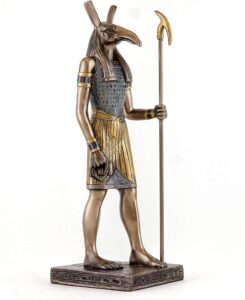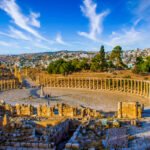Egypt statues are more than just stone carvings—they are monumental legacies of a civilization that thrived on creativity, power, and spirituality.
These extraordinary creations, from towering monuments to intricate figurines, represent the essence of ancient Egyptian culture.
Whether it’s the awe-inspiring statue of ancient Egypt’s pharaohs or the deeply symbolic Egyptian statues of gods, each piece tells a story of the past that still resonates today.
In this blog, we dive deep into the world of famous Egyptian statues, their meanings, craftsmanship, and where to find these timeless treasures.
Why Egypt Statues Are So Significant
The artistry of Egyptian statues reflects their pivotal role in ancient Egyptian society. These statues were more than just artistic expressions—
they were bridges between the earthly and the divine, immortalizing figures of power, devotion, and eternity.
- Religious Purpose:
Egyptian statues of gods served as vessels for the divine, embodying the presence of deities in temples and homes. - Symbols of Power:
Grandiose statues of ancient Egypt’s pharaohs proclaimed their god-like authority and preserved their legacy for millennia. - Eternal Guardians:
Tomb statues, such as shabtis, were created to serve the deceased in the afterlife, ensuring their eternal journey.
Exploring Famous Egyptian Statues
1. The Great Sphinx of Giza
- Why It’s Iconic: This is perhaps the most recognized statue of ancient Egypt, symbolizing strength, wisdom, and mystery.
- Details: The Sphinx features a lion’s body and the head of Pharaoh Khafre, embodying both power and intellect.
- Fun Fact: Its missing nose has fueled centuries of speculation, adding to the allure of this famous Egyptian statue.
2. Ramses II Statue Found at Memphis
- Why It’s Important: The monumental Ramses II statue found in Memphis highlights the grandeur of one of Egypt’s greatest pharaohs.
- Details: This towering statue, originally over 10 meters tall, is a powerful depiction of Ramses II as a ruler and a god.
- Legacy: This Egypt statue underscores Ramses II’s enduring impact on Egyptian history and culture.
3. The Seated Scribe
- Why It’s Unique: Among the famous Egyptian statues, this one stands out for its realistic portrayal of an ordinary man—a scribe.
- Details: Made of painted limestone, it depicts the scribe seated with a papyrus scroll, poised to document history.
- Symbolism: This statue of ancient Egypt celebrates literacy and the vital role of scribes in society.
4. The Colossi of Memnon
- Why They’re Famous: These colossal Egypt statues represent Pharaoh Amenhotep III and are among the tallest sculptures of their kind.
- Details: Standing 18 meters tall, they were believed to emit mysterious sounds at dawn—a phenomenon that captivated ancient travelers.
- Symbolism: These statues reflect the pharaoh’s eternal presence and divine connection.
The Role of Egyptian Statues of Gods
One of the most fascinating aspects of Egypt statues is their depiction of gods, each carefully crafted to convey the attributes and powers of the deity:

- Horus:
The falcon-headed god of protection and kingship, often represented as a guardian at temple entrances. - Anubis:
The jackal-headed god of mummification and the afterlife, symbolizing guidance and preservation. - Isis:
The goddess of magic and motherhood, often shown cradling her son Horus, symbolizing love and protection.
These Egyptian statues of gods were not just art but sacred objects central to rituals and worship.
How Were Egypt Statues Made?
The creation of Egypt statues required unparalleled skill and dedication, with techniques honed over centuries.
- Materials Used:
- Limestone, Granite, and Sandstone: Ideal for large, enduring statues, like the Ramses II statue found.
- Gold and Metals: Reserved for statues of gods and royal adornments.
- Wood: Used for smaller, intricate sculptures.
- Craftsmanship:
- Artists used simple tools like chisels and hammers to carve intricate details.
- Vibrant paint was often applied to bring Egypt statues to life, symbolizing their divine or royal nature.
The meticulous process ensured these famous Egyptian statues would withstand the test of time.
Understanding the Meanings Behind Egyptian Sculptures
Egyptian sculptures and their meanings are deeply intertwined with the culture’s beliefs and traditions. Key symbolic elements include:Egyptian Sculptures – 10 Most Famous – Artst
- Posture:
- Standing Pose: Represents readiness and action.
- Seated Pose: Signifies stability and authority, often seen in statues of ancient Egypt’s pharaohs.
- Gestures:
- Crossed Arms: Symbolizes eternal life and resurrection, associated with Osiris.
- Headdresses:
- Crowns and headdresses signify divine status and power, especially in Egyptian statues of gods and kings.
Every detail in these Egypt statues served a purpose, making them powerful conveyors of meaning.
Where to See Famous Egyptian Statues
To fully appreciate the grandeur of Egypt statues, here’s where you can find them:
In Egypt
- Giza Plateau: Home to the iconic Great Sphinx and the pyramids.
- Cairo Museum: A treasure trove of famous Egyptian statues, including the Seated Scribe.
- Luxor and Karnak Temples: Packed with monumental statues of ancient Egypt, including those of pharaohs and gods.
Around the World
- British Museum (London): Features remarkable Egyptian statues of gods and pharaohs.
- Louvre Museum (Paris): Houses stunning artifacts, including sphinxes and busts.
- Neues Museum (Berlin): Famous for the exquisite bust of Nefertiti, an iconic example of Egyptian sculpture.
Virtual Tours
Many museums now offer online tours, allowing you to explore famous Egyptian statues from the comfort of your home.
Why Egypt Statues Continue to Fascinate Us
What makes Egypt statues so captivating even today?
- Timeless Artistry: The intricate craftsmanship of these famous Egyptian statues is unmatched, showcasing the genius of ancient artisans.
- Mystery and Myth: Stories like the singing Colossi of Memnon or the missing nose of the Sphinx keep these statues shrouded in intrigue.
- Cultural Influence: Egypt statues inspire modern art, design, and architecture, proving their lasting impact.
Bringing Egypt Statues into Your Life
For those enchanted by Egypt statues, here are some ways to connect with their beauty:
- Replica Statues: Decorate your home with authentic replicas of famous Egyptian statues, perfect for any history lover.
- Egyptian Jewelry: Wear pendants and charms inspired by Egyptian statues of gods, such as the Eye of Horus or Ankh.
- Books and Documentaries: Delve deeper into the history and symbolism of Egyptian sculptures and their meanings.
Conclusion: The Eternal Legacy of Egypt Statues
Egypt statues stand as eternal reminders of a civilization that mastered art, spirituality, and storytelling. From the majestic Great Sphinx to the powerful Ramses II statue found at Memphis, these sculptures tell stories of pharaohs, gods, and the journey to eternity.
Whether you visit Egypt, explore museum collections, or admire replicas, the magic of famous Egyptian statues continues to inspire and amaze. The world of Egypt statues is a testament to human ingenuity and a bridge to the ancient past—a legacy that will never fade.





